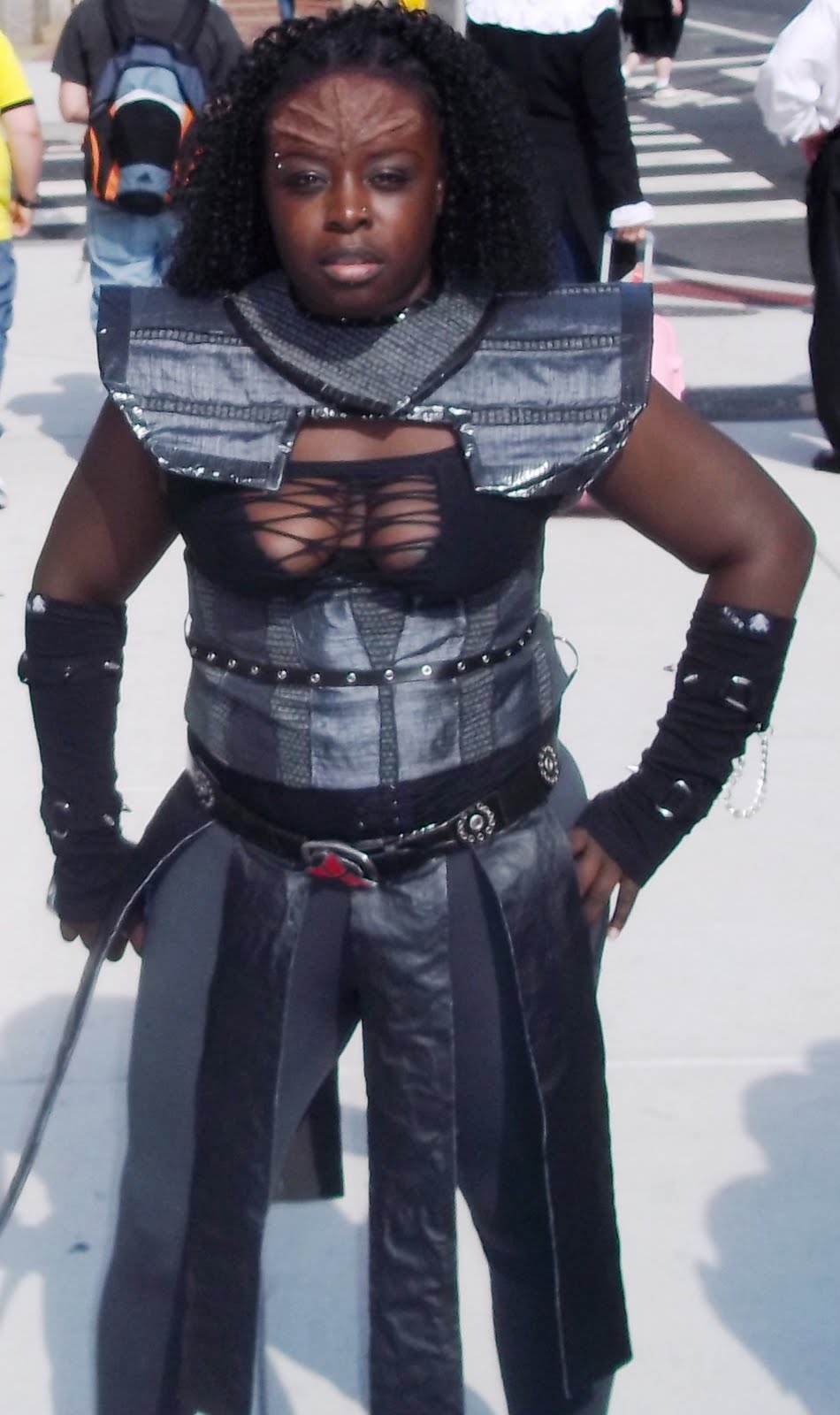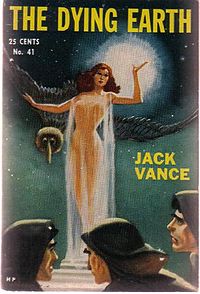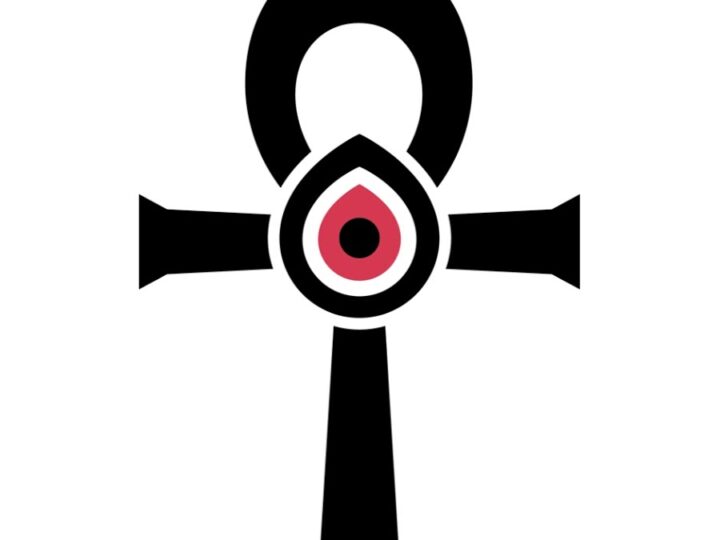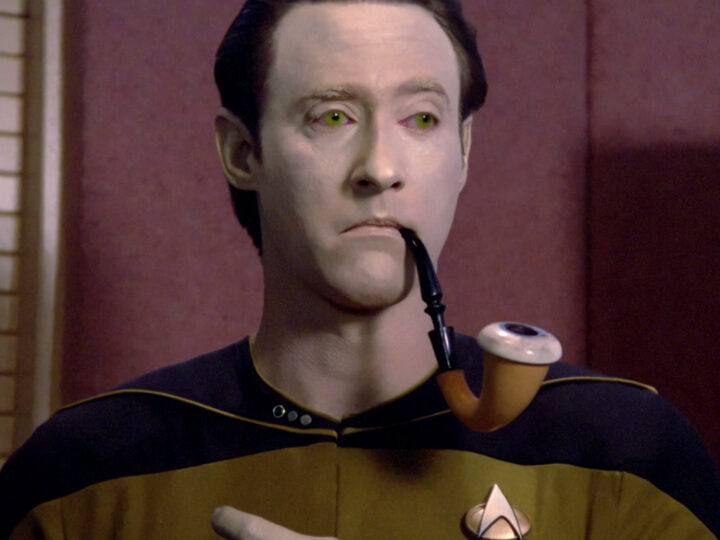
Travels into the Dark Side of Trekkerdom
The dealer floor of the latest Star Trek Creation Convention is closed, the day’s security work is done, and in a darkened Ramada Inn conference room, the Klingons prepare for their ritual, Tera’daq Tlhinganghom’mey. The hulking beings, all members or allies of the Karizan Empire, file past a table in silence, depositing their energy weapons in a pile. Incense chokes the room as twelve aliens, both male and female, take their seats around an altar. Candlelight reflects off the latex ridges of some foreheads, and the soundtrack of Bram Stoker’s Dracula plays on a nearby tape deck. The impressively-built Mok walks counter-clockwise about the altar, brandishing a hammer of Thor as he invokes the heroes of old and demands their presence at the gathering. The candles shake as he slams the hammer on the table. “We are between the worlds,” he announces.
A huge, balding man enters, supporting himself on a cane. He is Korghas, supreme commander of KLAW, the Klingon Legion of Assault Warriors. Like many of those present, Korghas is not in garb, but he radiates klin, that volatile essence of the Klingon. KLAW and the Karizans have fought bitter fanwars in the past, but now an uneasy peace exists between the clubs. Korghas watches with amused dispassion as Mok, the Karizan Orm, or high priest, formally dissolves all standing alliances and freezes the current membership—Klingons can neither join nor leave the club. Suddenly a shout rings out, and a violent coup attempt against the Imperitor Kargh Restarc ensues. Cries of “petaQ!” and “cheese-grater head” fill the air, and role-playing dice hit the carpet like broken bones. When the smoke clears, Kargh stands tall.
Afterwards, the Klingons gather for a toast of Romulan ale. The blue ooze tastes distinctly like schnapps.
***
The specter of the geek haunts Star Trek fandom. Few have forgotten the Saturday Night Live skit where William Shatner, playing himself at a convention, proclaimed to a passel of bespectacled weenies that they should “get a life.” And Trekkers know that the vast majority of mundanes—fanspeak for those of you who do not grok—put them in the same boat as computer junkies, Dungeons & Dragons devotees, and SF paperback gluttons: a bunch of maladjusted, pimple-faced wonks.
But even a glance at a con will reveal that Trekkers are ethnically and generationally diverse, are as likely to be female as male, and display no more incidence of acne than the crowd at a Depeche Mode concert. While encouraging much trivial consumption and claustrophobic socializing, the con also creates what the Sufi underground anarchist Hakim Bey calls a “temporary autonomous zone.” Loosing themselves from the mundane demands that nail the adult world in place, fans are free to play-act, lust over aliens, and make goofy puns. But this free zone requires lots of work too: Fans churn out reams of zines and fiction, build models of battle cruisers and phasers, stitch together costumes, and perform filksongs (slang for frequently parodic fan songs). And most fans share a good degree of irony and humor about their “weekend-only world.”
And some dress-up as ferocious, scowling aliens who like their combat brutal, their conversations blunt, and their sex ferocious. Dress-up Klingon fan clubs were born in 1974, when Robert Asprin formed the Klingon Diplomatic Corps to provide security at cons, but the race has really been rearing its gnarly head of late. The Klingon language, tlhIngan, a self-consistent tongue concocted by the linguist Mark Okrand for the third Star Trek movie, has lately drawn strong interest from fans and the press, and has led to a best-selling dictionary, a language tape, the semi-academic zine HolQeD, and a summer camp. Besides proliferating at cons, members of the passionate and noble race have also been spotted in the darker corners of New York City dance clubs. A sample of dialogue from Worf—the resident Klingon on Star Trek: the Next Generation—opens a recent album by Orbital, a popular techno group. And Los Angeles Laker James Worthy was granted his wish to play a Klingon. He appeared as a six-foot-nine mercenary in a recent ST:TNG episode.
Though many things to many people, Klingons are not geeks.
***
Prince Keon of the Kreene line makes his home in the sovereign Klingon states of the Darkhold Nebula of the Karizan Empire, a small enclave of about 70 star systems hidden in the dark matter of an ion-storm nebula. There he and his people lurk, swiping technology from anyone foolish enough to slip into their space: Romulan, Klingon, Federation. Like many Klingons a large individual, Prince Keon is a hybrid, a kind of energy vampire bred from Klin blood and a mysterious breed—possibly genetically engineered—discovered in his father’s day.
Prince Keon is also 29-year old Lenny Greene, a long-haired ex-Army man of great good humor who resides in Long Island, where he drives a bus for mentally handicapped kids. “Basically Long Island is under my command,” he says with a grin. His Klingon sash is peppered with various fan pins, the Karizan stella, security badges, and an army decoration for proficiency with grenades and rifle (“that’s for real”). In Germany, Greene was part of the Dirty Thirty force who would mobilize to protect “the army’s big stick”: truck-mounted Pershing missiles. Alongside the simulated drills Green would perform as part of his duties, he participated in Starship tactical role-playing games. Military service also exposed Greene to Neo-paganism, the contemporary practice of reconstituting Europe’s pre-Christian nature religions. He chuckled when I raised an eyebrow in surprise. “Oh, there are lots of Pagans in the armed forces.”
Having already participated in a “war machine,” Greene was attracted to both the code of honor and the pragmatic, no-nonsense worship that marks Klingon warrior society. “The Klingons are very similar to the Norse, the Japanese samurai, Genghis Khan. It makes sense—if your taking from those people, not only are you gonna take their organization, but your gonna take the basic concept of their religion.”
Ambassador Khristine Arengar Azhir plops down next to Keon and cools him off with a Japanese fan. He starts to massage her stockinged feet. “We’re a crazy lot,” she says to me. “Like one big happy dysfunctional family.” A pale brunette with large glasses, a stick-on dragon tattoo, and a button that reads “To Hell with the Prime Directive I’m Going to Kill Something,” Khristine wears decidedly kinky garb—along with a short black skirt, black stockings, black fingernail polish, and pumps, Khristine’s “showpieces” include a cat-o’-nine tails, a riding crop, and a knife jammed into her red garter (it’s actually a key chain).
The 23-year-old unemployed billing clerk from Queens proceeds to explain the “hodge-podge smorgasbord” of Pagan elements that go into the Tera’daq ritual, fingering the pentagram and the Bajoran symbol that dangle from her neck. “Mostly this is for show. We would have fog machines if we could afford it.”
“We’re not really doing anything,” Keon insists.
“When we do Tera’daq we are in character. Once you close the door, you’re it. Once you walk out the door, you’re back in your normal life. When I play my character it’s sort of like a different person, but it’s part of myself, something that no one can take away. Klingon is what’s inside you. You have to let it out.”
Khristine found that getting in touch with her inner Klingon was not only fun, but empowering. “One of the reasons I became a Klingon was that I was going through a bad relationship and it helped me build self-confidence. I like interacting with people, growling at them and stuff. It’s healthy for me,” she says. “It keeps me sane, actually. A lot of people here are paramedics or work in law enforcement and public safety. Stressful jobs. This is a way to act out. ‘Cause they see the darker side of reality.”
***
With their Siberian swagger and their talk of empire and conquest, the Klingons on the original Star Trek series obviously represented the Soviets. But by the mid-’80s, glasnost forced Paramount’s hand, and in the sixth Star Trek film the Klingon Empire and the Federation moved towards peace. The Star Trek movies also opened up Klingon subjectivities—literally. For the first time, we saw the dark, cramped interiors of Klingon ships and met the Imperial race—the Klingons with the walnut ridges on their foreheads. As one fan put it, Klingons were no longer “just guys painted brown with a Fu Manchu mustache.” But perhaps most importantly, the movies gave us the harsh, guttural Klingon tongue, which, years before Dances With Wolves, was respectfully subtitled.
By the time Star Trek: the Next Generation takes place (70 years after the original series), the Klingons have formed a tentative alliance with the Feds. ST:TNG added a further twist by placing a Klingon on the bridge (like many Klin fans, doing security). Raised by humans, Lieutenant Worf constantly struggles with his split identity, and in some of ST:TNG‘s best episodes, Worf wrestles with—and gives into—the call of his Klingon blood. By casting Worf and many Klingons with African-American actors (most notably, Tony Todd as Worf’s brother Kurn), ST:TNG added an alien dimension to TV’s tentative engagement with cultural difference. Taken solely as racial allegories, Klingons come off as galactic gangsta rappers with Afrocentric pride—like most liberal and mainstream representations of ethnicity, a thoroughly problematic blend of stereotypes and positive imagery.
But as good myth-weavers know, the potency of myth lies in the magic of ambiguity. Myth derives its power from twilight, from straddling the here and there, like those optical illusions in psychology textbooks that signify different images depending on how you look at them. Strong myth has room for many specific and contradictory functions, political or otherwise, but it always opens up into another secret garden. No matter how much you allegorize Klingons, as Russkies or black nationalists or creatures from the id, they are compelling because they retain a certain nomadic volatility—what the zine Katra calls “outliness.”
The Karizan Klingons who gathered in the Ramada Inn are even more iconoclastic than most Trekkers, and their ritual conjures meanings only hinted at on the screen. Like Greene, most of the members of the club are Neopagans, part of a small but growing tribe of folks who have concocted a pre-/post-Christian religion out of nature worship, boho sensibilities, the recovery of the Goddess, and the Wiccan revival cobbled together by Gerald Gardner and other British witches in the mid-1900s.
The Karizans are not alone in their heathen fandom—while Neopagans groove to lunar cycles and the ancient wheel of the seasons, and conjure forth archaic pantheons within a decidedly pre-Enlightenment aesthetic, a significant chunk of this magical community are also serious SF fans. Both fans and witches share a very concrete sense of the power of the imagination, seen not as an elite realm restricted to “artists” (or TV producers) but as a vital phantasmic faculty that links the realms of fantasy with the here and now. Most of us lose this vigorous sense of imagination when we age, but both fans and Pagans learn to recover it, feed it, manifest it. There are more differences between fandom and Neopaganism than similarities, and even the Karizans insisted that the Tera’daq ritual was a “show-piece”—not a real Pagan ritual but a way to play with their magical leanings within the Trek mythos. But by performing their spiritual sensibilities within the trappings of a TV show, the Karizans also revived the oldest derivation of the word “fan:” fanaticus, a devotee of the ancient mystery cults.
***
Panaytiois K. Venetis enters the Ramada room where the Karizans take a break from working security. “It’s a cluster fuck out there,” he says, plopping down. Bearded and built like the Norse thunder god whose hammer he wears around neck, Venetis radiates an intelligent and heroic charisma. As K’Thor, leader of the Karizans, many considered him a power-mad demagogue before he staged his own ouster.
“It’s no coincidence that a lot of people who are first-generation immigrants are kinda schizophrenic and get into subcultures,” says Venetis, who grew up attending Greek parochial school and hearing the tales of the heroes of old. “You’re receiving contradictory feelings between your upbringing and the culture you’re transplanted in, which is giving you a whole new set of messages. So you gotta wend your way through that and not go crazy.”
Attending the Bronx high school of science, Venetis became aware of Neopaganism. “It seemed to be something invented rather than something that survived from antiquity. So I figured I might as well invent my own worship.” While working as a rehabilitation counselor in City Hospital, he decided to form a Neopagan group that would mix European lore with the precepts of warriorhood he had been gleaning from his martial arts practice. “I had been exposed to role-playing, so I wanted to use that as a way of experiencing the mythology a little more directly than just reading or writing it.”
Finding that Norse mythology was alien to most of his group, he decided to use more familiar aliens instead. “At that time, the movies were portraying the Klingons in a very Viking manner, as independent raiders with a warrior culture, so it was very easy to adapt that to the mythical structure I was working on.”
When Venetis and his crew started going to cons in character, they stirred up a lot of controversy. “We were Neopagan so we brought a lot of Neopagan elements. It was theatrics, but a lot of people here are born-again Christians and we used to freak them out.” Rumors of sex orgies and blood sacrifice began circulating, so the Karizans began weaving together the most outrageous tales in their zine The Void Warrior and then admitting to them. “We deny nothing” was their battle cry.
***
In The Practice of Everyday Life, the French theorist Michel de Certeau describes the tactics used by popular readers as “poaching.” Excluded from the meanings legislated by critics or academics, “readers are travelers; they move across lands belonging to someone else, like nomads poaching their way across fields they did not write, despoiling the wealth of Egypt to enjoy it themselves.” As Henry Jenkins points out in Textual Poachers, his solid study of media fandom, de Certeau’s model lends itself to TV readers as well. “Within the cultural economy,” Jenkins points out, “fans are peasants, not proprietors.” Everything they touch is copyrighted, and even their best-loved products can be canceled.
Fan fiction writers weave their stories from the threads Hollywood leaves dangling, creating both an overarching consistency to their favorite shows and a body of off-kilter, contradictory tales of parallel universes, time slips, and love affairs the series writers would never dare suggest. Going far beyond the parameters of the original series, this labor of love transforms the passivity of watching TV into a creative, and sometimes critical, practice. Cultural studies folks have begun to pay attention to media fandom, which includes shows as diverse as Starsky & Hutch, The Avengers and Beauty and the Beast as well as Star Trek (which draws both media and SF fans). For obvious reasons, these scholars are particularly drawn to fan stories which depict Kirk and Spock (and other buddy teams) getting it on with each other—though the focus on such “slash” fiction, written almost exclusively by straight women, says as much about academia as it does about fandom.
For these stories, like other products of fandom, become meaningful only in the context of community. Fan writing, with its sampling, genre conventions, and relative lack of emphasis on individual authorship, produces not so much definitive stories as a shifting collective body of lore. Beefy zines like the Klingon Agonizer contain not only fiction but also recipes, sewing instructions, technical specs, poems, con reports, and filksongs, like the “The Earthly Klinbillies,” with melodies cribbed from TV shows. Only one of many tactics fans use, lore helps carve out a distinctly popular space within the bowels of the culture industry. Perhaps the best demonstration of this peasant logic is the con itself—a seasonal festival of play and excess that would fascinate Bakhtin. The term filk describes this logic perfectly—fandom is filched folk culture.
Perhaps the intense vitality of some Klingon groups, though they represent a small portion of Trek fandom, arises from the fact that they already imagine themselves to be pillaging nomads. Comparing the Karizans to KLAW and Federation clubs, Lenny Greene almost scoffs. “You’ve got some groups who will only adhere to what has been canonized by Paramount. Or they use FASA as their Bible. [FASA is a role-playing game company that issued a plentiful book on Klingons.] That’s good for people who like their conformity, and the Feds are very conformist. They don’t like us because we are so different. We take the ball and run with it.”
Appropriately, the religious imaginations of the Karizan folks are in step with the postmodern folk bricolage of fandom. Greene defines himself as an “eclectic solitary”—meaning that he is not in a “traditional” Wiccan coven. He uses bits of Asian, Amerindian, and Wiccan lore. “Lately there is a bit of Norse flavoring. I just mesh all this stuff together in my own mind to find what works. It’s a practical, common-sense approach.” Greene left KLAW not only because it was too conformist and hierarchical in style, but because the founder was a hard-core Baptist. “We all know about the old days,” he says with a knowing grin.
Noting that many Paramount folk attend conventions, Greene insists that the Karizan emphasis on Klingon ritual has influenced ST:TNG‘s portrayal of Klingon culture. “They’re sort of borrowing from us. Hollywood is not that creative; they steal most of their ideas. We don’t mind, because they give us kudos for this.” Greene’s proof, such as it is, is a mention Commander Sisko of Deep Space Nine makes of “some girls down on Karizan” and the placement of a Karizan insignia on Galron’s seat in an episode of ST:TNG. “You can’t see it unless you have a crystal-clear copy,” Greene says. The truth of the debt doesn’t really matter. In the symbiotic world of fandom and culture industry, no one controls the meaning of the Klingons—though if push comes to shove, Paramount owns them. As Greene said, “There’s a feedback. Paramount feeds off fandom, fandom feeds off Paramount. It’s a wonderful cycle.”
***
Decked out in boots, a golden sash, and Klingon bustier, her long black hair falling loose aside remarkable forehead ridges, Admiral Ka’Hil Zantai Dok’Marr, the Legion Sub-Commander of KLAW, is costumed far more impressively than any of the motley Karizans. After I requested an interview with Ka’Hil, a hulking marine glowered at me and pulled her aside. It turned out that some renegade KLAW member had moved to Florida had founded a zine called The Pillage Voice, and the Klingon was concerned for the safety of his commander.
Though she’s been a fan since she was a kid, Ka’Hil—Ines Peek—only recently became involved in Klingon, after surviving a horrible accident in which she lost her husband. “I was in a wheelchair, with no prospects of walking again. I was about to kill myself. I was suffering from insomnia, and the TV was on 24 hours a day. At midnight, Channel 11 used to show the old Star Trek series. I was getting razor blades to kill myself, and Kirk, just by a twist of fate, was making one of his impassioned overacted speeches about the sanctity of human life. It just stopped me in my tracks.”
Born and raised in the Bronx, Peek comes across as a strong, self-controlled person with a great deal of clarity about the division between fandom and the world. “In real life, I’m Ines Peek, but today I’m not. I’m Ka’Hil, with everything that entails. If you saw me in corporate America, you’d be very surprised,” she says with a rare smile.
Peek likes the Klingons because “they are very honor-bound and very pragmatic. I’ve had a life where being tough meant surviving, and I like the Klingon toughness and survival instincts.” This also explains her attraction to the hierarchical structure of KLAW. “I started out as a lowly commander on somebody’s ship in charge of communications, and now I’m vice president of the Legion. Ka’Hil is very no-nonsense, spit’n’polish, very physical. She got through with no family connections.”
Unlike the Karizans, KLAW demands a great deal from their members—everyone has to make their own latex forehead ridges, for example. “It’s enormously creative,” Ka’Hil says. “People who never wrote a letter to their mother are all of a sudden writing Klingon stories and poetry. We have Klingon cuisine. We eat a lot of seaweed and strange mushrooms, and we serve the meal with no silverware, and people are belching at the table.”
Very diplomatically, Ka’Hil acknowledges the acrimony and back stabbing between her club and the Karizans. “But we finally all sat down and said, ‘Look, there is no judgment here. It’s IDIC,'”—a reference to the commonly-held Vulcan philosophy of Infinite Diversity in Infinite Combination, an ethos as Spinozan as it is multicultural.
All small groups share small group politics, from garden clubs to anarchistic collectives. But Klingon fandom has the advantage of being able to act out their highly volatile system of alliances and fanwars on the level of myth as well as club organization. The day following our interview, Ka’Hil approached me in order to keep me abreast of the latest developments. It seems that when we spoke, Ka’Hil was contemplating leaving KLAW. “But my honor bound me to speak to you as a member of KLAW.” Later that night, Korghas accepted her resignation in a hotel suite. “I turned my back on him and my crew and walked away. After that my crew made their own decisions to follow or not. Then we all went back in the room and had some pizza.”
Kyxak Solazarn enters the Karizan security room. With long cornrows, a strikingly attractive face, a “pure vinyl” suit, tights, and a con handstamp on her breast, Kyxak embodies the Valkyrie/Amazon archetype of the Klingon female. A Bajoran calls out, “Women with Klingon ridges drive me wild!” She bares her teeth and growls.
Later I track down Solazarn, who works in engineering on Admiral Ka’Hil’s ship Puqbe’ K’ Ramjep (Daughter of Midnight). “Kyxak is independent, pretty much what you’d call the misfit of the group,” explains 26-year-old Danielle Thompson, who lives “and will probably die” in Jackson Heights, Queens, with her daughter Olivia.
Like her commander, who is also African-American, Thompson insists that race had nothing to do with her attraction to Klingons. “No! In Klingon society, there’s no such thing as black and white. You’re either Imperial, with the forehead, or you’re irrelevant.” She grins. “Even if your a fusion (mixed-race), you’re treated as one of the group. There’s no such thing as me, me, me.
“Role playing gives me a chance to act out my fantasies. When I was a kid I used to think about being from a different planet, traveling the stars, being someone other than Danielle Thompson, this only child. I kept telling myself, these aren’t my real parents, I’m from some other planet and my real parents are going to come pick me up soon. So I developed a real fascination with space and exploration.”
She likes working security as a Klingon because “You get to have attitude. You get to walk up to other people and tell them what to do and not explain why. And if you bump into someone you don’t have to say ‘I’m sorry’—two words we never say. It’s pure power.”
I point to her riding crop. “Oh that? That’s just something to hold onto. When I’m doing crowd control, its just an extension of my arm. As far as domination, I don’t need this.”
***
Joe Zuchowski, a short, solidly-built 36-year-old with hefty glasses, comes off as an intense and kindly man. As a loner Klingon unaffiliated with any club, Joe pops up less at Trek cons than at the local Neopagan events sponsored by New Moon New York and Circle Gateway, where he frequently breaks into Imperial fight songs and elaborate, spit-flinging ritual curses in impeccable tlhIngan. In the real world, he works as a maintenance attendant at a bowling alley in Jersey City.
“When Star Trek came on in the ’60s, it was almost like the answer to a prayer,” he says. “I didn’t have a very pleasant childhood. My father was not home, my mother was very emotionally unstable—it was like living on a knife’s edge. Star Trek was my only way of dealing with things. I could project myself into it. At first I tried to the Vulcan thing, the repression of emotions. But because of a lot of anger within me, I found myself gearing towards the Klingons. They could be nasty without an excuse; they could be brusque and volatile and explosive. They offered no apology to anybody. That was their culture.”
Ever since his grandmother told him Ukrainian tales of ghosts and goblins, Zuchowski has been attracted to the mysteries of the dark. As a kid he played role-playing games and dabbled in teen Satanism. Then he met a real Wiccan—a friend’s sister’s hairdresser—and joined a coven. (“If there are any Christians reading this, they’ll say ‘See, see there’s the pattern! D&D, Satanism, witchcraft, Klingon, right there!'”) Over the years he opened up to the Norse warrior gods, partly because of their imaginative richness. “You say the word Viking and into your mind pops this horn-helmeted, sword-wielding, howling berserker charging off a longboat. You can very easily take that Viking warrior, put him in Klingon armor, hand him a disrupter and have him coming out of a Bird of Prey. It’s just transposition.”
Having been into Klingons since the 70s, Joe makes no bones about their appeal. “It’s the human fascination with its own dark, brutal side. Klingons are predators. They are cunning and shrewd, but it’s all based on a warrior code of ethics, like Japanese bushido or the code of chivalry of the medieval knights. A Klingon takes pain as a catalyst, using the pain to push him on. The pain is real, my suffering is real, my experience is real. Like they say in Conan the Barbarian: that which does not kill me makes me stronger.”
Recognizing that many folks within and without the Neopagan community get the willies at the mention of warrior societies and the worship of Germanic gods, Joe insists that “the warrior has gotten a very bad name. Today, it’s not a warrior anymore. It’s a militarist. A warrior understands why he or she is fighting. Nobody tells me who my enemies are. I know who my enemies are: ignorance, fear, prejudice.” Joe has done abortion clinic defense and sees Neopaganism as part of larger social concerns.
“When Pagans talk about the Burning Times, the Inquisition, it wasn’t against witches per se, it was a war against the enemies of the church: Jews, Moslems, heretics, homosexuals, women. The original pagans did not come from a world of moonlight, veganism, and faeries. Survival was a struggle. Pagans today, whether they realize it or not, are also tapping into that warrior spirit. We’re fighting for our identity, for our rights. We’re fighting to keep our world alive and relatively intact. The Pagan spirit is alive.
“The Klingon does not fear death because the moment you are facing your death is the moment you are most alive. You realize what life is all about, not this piddling day-to-day existence: get up at seven, have your breakfast, kiss your wife good-bye, go to work, come home at five, bitch and moan, maybe get it on, and then repeat the whole procedure again. Then you find out you have an ulcer. But if you’re in your imagination, and you’re out there in a Klingon battle cruiser, for those few, brief, precious moments that other life doesn’t matter and you can live out your dreams.”




